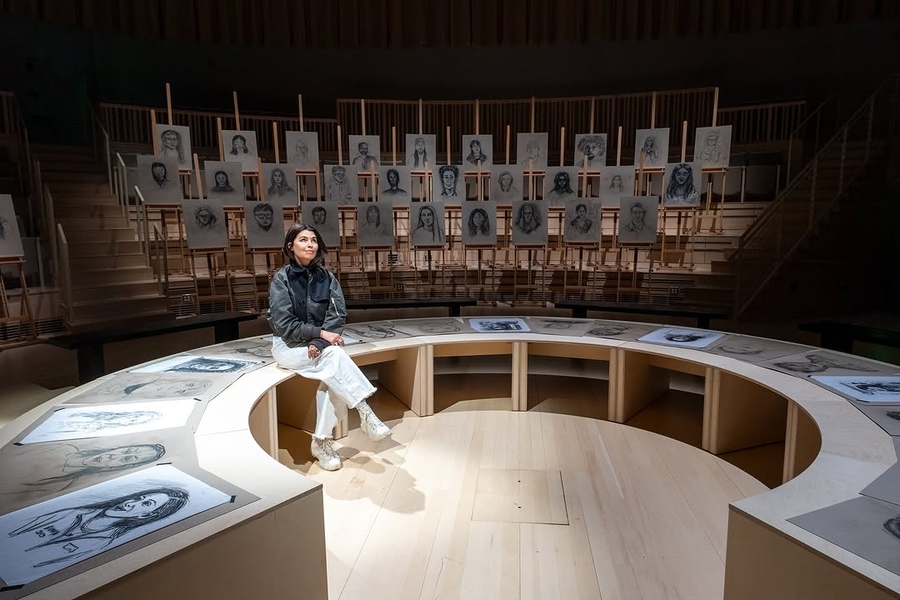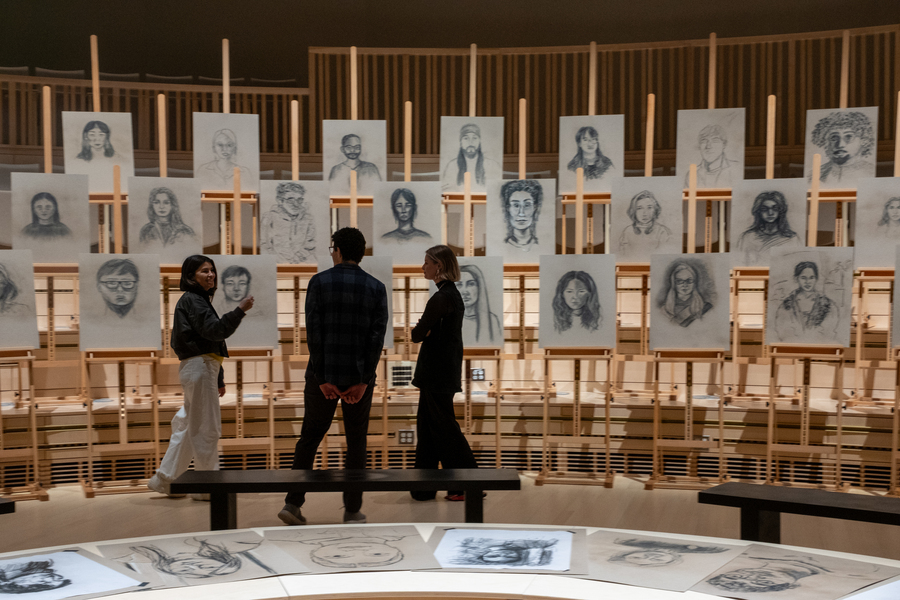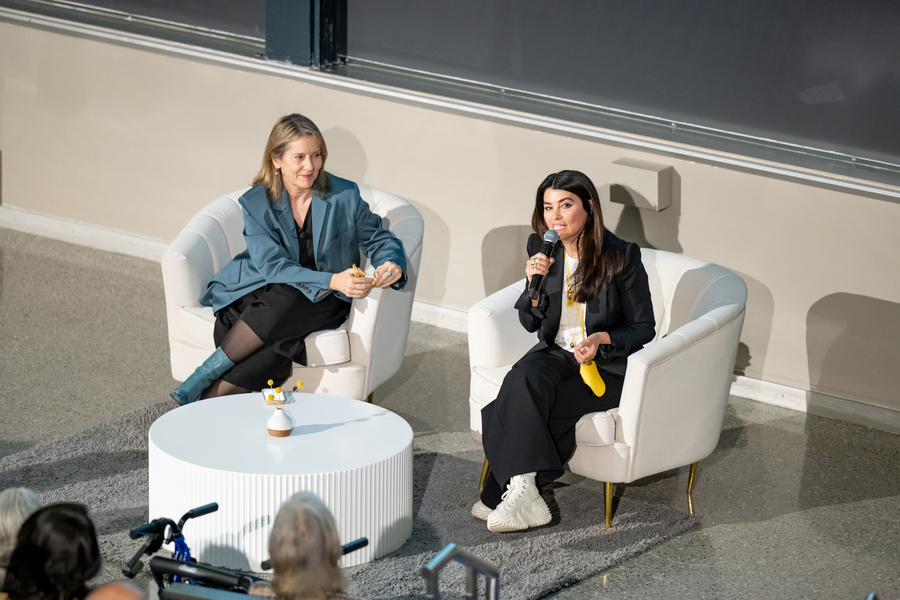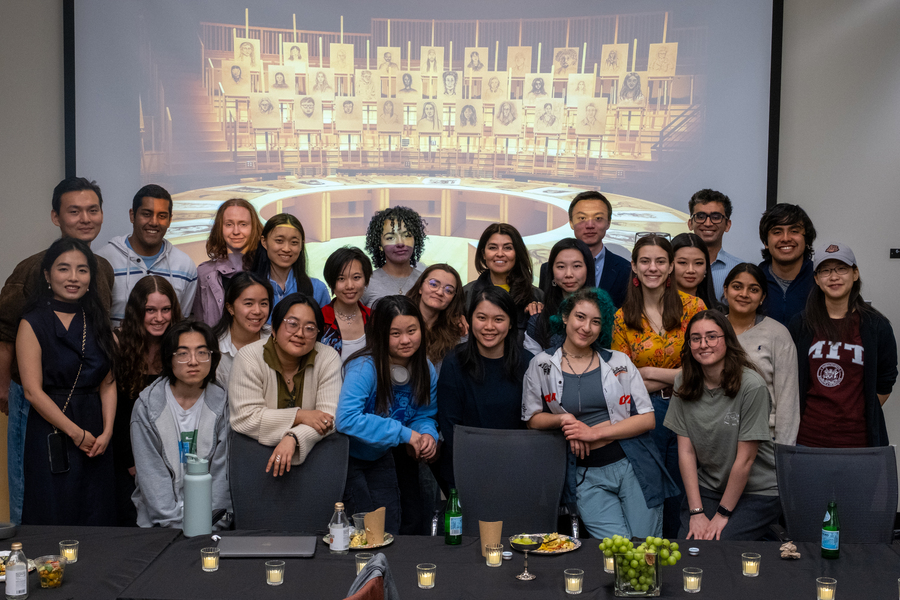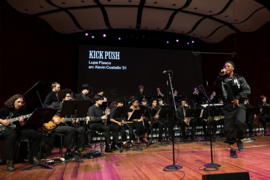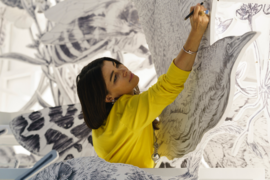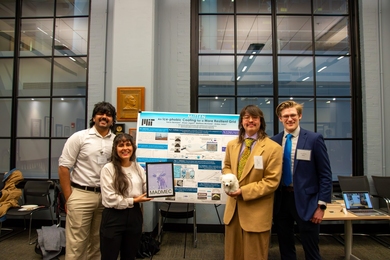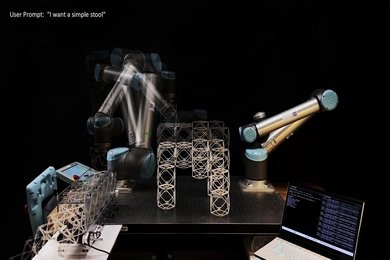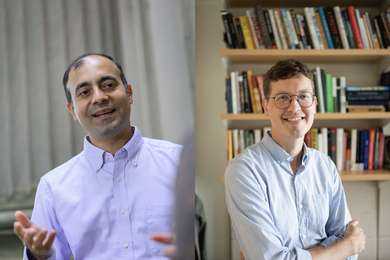Es Devlin, the winner of the 2025 Eugene McDermott Award in the Arts at MIT, creates settings for people to gather — whether it’s a few people in a room or crowds swelling a massive stadium — arenas in which to dissolve one’s individual sense of self into the greater collective. She herself contains multitudes; equally at home with 17th century metaphysical English poet John Donne, 21st century icon of music and fashion Lady Gaga, or Italian theoretical physicist Carlo Rovelli.
In the course of the artist and designer’s three-decade career, Devlin has created an exploded paint interpretation of the U.K. flag for the Closing Ceremony of the 2012 London Olympics, a box of illuminated rainfall for a production of the Crucible, a 65-foot diameter AI-generated poetry pavilion for the World Expo, an indoor forest for the COP26 Climate Conference, a revolving luminous library for over 200,000 in Milan, Beyonce’s Renaissance tour, and two Super Bowl halftime shows. But Devlin also works on a much smaller scale: the human face. Her world-building is rooted in the earliest technologies of reading and drawing: the simple acts of the eye and hand.
For Congregation in 2024, she made chalk and charcoal drawings of 50 strangers. Before this project, Devlin says, she had most likely drawn around 50 portraits in total over the course of her practice — mostly family or friends, or the occasional covert sketch of a stranger on the subway. But drawing strangers required a different form of attention. “I was looking at another, who often looked different from me in many ways. Their skin pigmentation might be different, the orientation of their nose, eyes, and forehead might be other to what I was used to seeing in the mirror, and I was fraught with anxiety and concern to do them justice, and at pains not to offend,” she recalls.
As she drew, she warded off the desire to please, feeling her unconscious biases surface, but eventually, in this wordless space, found herself in intense communion. “I gradually became absorbed in each person's eyes. It felt like falling into a well, but knowing I was held by an anchor, that I would be drawn out,” she says, “In each case, I thought, ‘well, this is it. Here we are. This is the answer to everything, the continuity between me and the other.’” She calls each sitter a co-creator of the piece.
Devlin’s project inspired a series of drawing sessions at MIT, where students, faculty, and staff across the Institute — without any prior drawing experience necessary — were paired with strangers and asked to draw each other in silence for five minutes. In these 11 sessions held over the course of the semester, participants practiced rendering a stranger’s features on the page, and then the sitter spoke and shared their story. There were no guidelines about what to say, or even how to draw — but the final product mattered less than the process, the act of being in another’s presence and looking deeply.
If pop concerts are the technology to transform private emotional truth into public feeling — the lyrics sung to the bathroom mirror now belted in choruses of thousands — Devlin finds that same stripped-down intimacy in all her works, asking us to bare the most elemental versions of ourselves.
“We’re in a moment where we’re really having a hard time speaking to one another. We wanted to find a way to take the lessons from the work that Es Devlin has done to practice listening to one another and building connections within this very broad community that we call MIT,” says Sara Brown, an associate professor in the Music and Theater Arts Section who facilitated drawing sessions. The drawings were then displayed in a pop-up group exhibition, MIT Face to Face, where 80 easels were positioned to face the center of the room like a two-dimensional choir, forming a communal portrait of MIT.
During her residency at MIT, Devlin toured student labs, spoke with students and faculty from theater arts, discussed the creative uses of AI with technologists and curators, and met with neuroscientists. “I had my brain scanned two days ago at very short notice,” she says, “a functioning MRI scan to help me understand more deeply the geography and architecture of my own mind.”
“The question I get asked most is, ‘How do you retain a sense of self when you are in collaboration with another, especially if it’s another who is celebrated and widely revered?’” she says, “And I found an answer to that question: You have to be prepared to lose yourself. You have to be prepared to sublimate your sense of self, to see through the eyes of another, and through that practice, you will begin to find more deeply who you are.”
She is influenced by the work of philosopher and neuroscientist Iain Gilchrist, who suggests that a society dominated by the mode of attention of the left hemisphere — the part of the brain broadly in charge of language processing and logical thinking — also needs to be balanced by the right hemisphere, which operates nonverbal modes of attention. While the left hemisphere categorizes and separates, the right attends to the universe as an oceanic whole. And it is under the power of the right hemisphere’s mode of attention, Devlin says, that she enters the flow state of drawing, a place outside the confines of language, that enables her to feel a greater sense of unity with the entire cosmos.
Whether it’s drawing a stranger with a pencil and paper, or working with collaborators, Devlin believes the key to self understanding is, paradoxically, losing oneself.
In all her works, she seeks the ecstatic moment when the boundaries between self and world become more porous. In a time of divisiveness, her message is important. “I think it’s really to do with fear of other,” she says, “and I believe that dislodging fear is something that has to be practiced, like learning a new instrument.” What would it be like to regain a greater equilibrium between the modes of attention of both hemispheres of the brain, the sense of distinctness and the cosmic whole at once? “It could be absolutely definitive, and potentially stave off human extinction,” she says, “It’s at that level of urgency.”
Presented by the Council for the Arts at MIT, the Eugene McDermott Award for the Arts at MIT was first established by Margaret McDermott in honor of her husband, a legacy that is now carried on by their daughter, Mary McDermott Cook. The Eugene McDermott Award plays a unique role at the Institute by bringing the MIT community together to support MIT’s principal arts organizations: the Department of Architecture; the Program in Art, Culture and Technology; the Center for Art, Science and Technology; the List Visual Arts Center; the MIT Museum; and Music and Theater Arts. During her residency at MIT she presented a week of discussions with the MIT community’s students and faculty in theater, architecture, computer science, MIT Museum Studio, and more. She also presented a public artist talk with Museum of Modern Art Senior Curator of Architecture and Design Paola Antonelli that was one of the culminating events of the MIT arts festival, Artfinity.
